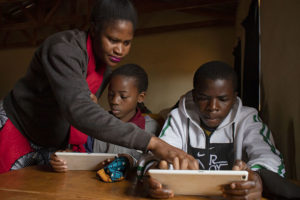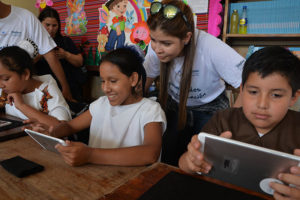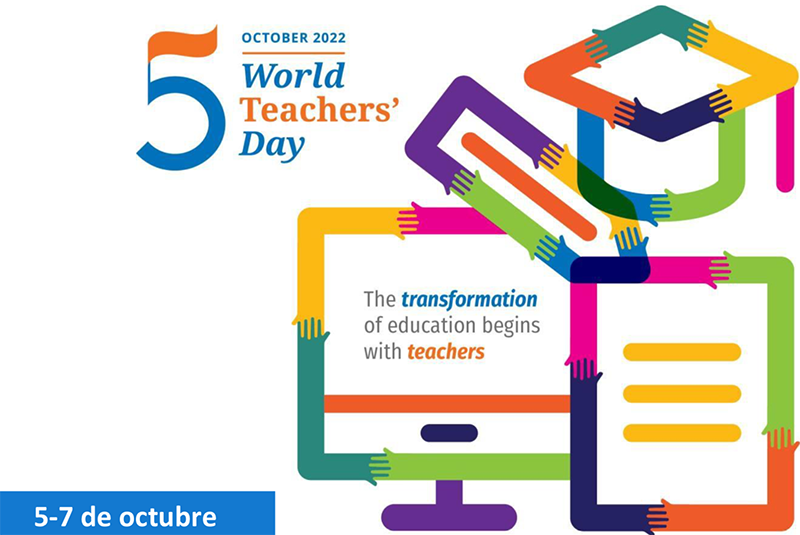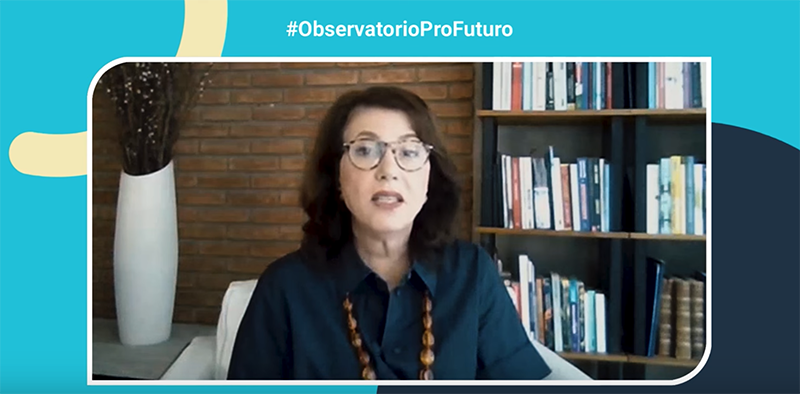Are we aware of the importance of the teaching profession in our society? Are teachers where they should be? Here at the Observatory, we’re bringing you three reasons to celebrate World Teachers’ Day.
Reason #1: Teachers are and will remain the cornerstone of the education system

Photo: Teacher and pupils at a school in Nairobi. © Ismael Martinez
Teachers have always been the driving force of education systems. Without them, it’s impossible to provide quality, inclusive and equitable education to all students. We all know about Plato, Socrates and Maria Montessori. But beyond the major figures who transformed the history of education and shaped the history of humanity, almost all of us also carry with us the memory of a teacher who impacted our lives in some way.
This has always been the case and will continue to be so in these revolutionary times we are living through, in which the emergence of new technologies in education is bringing about an epochal change comparable only to the invention of the printing press, and which will forever change the way we learn and teach.
Although at the beginning of this technological revolution people in some fields were predicting the end of the teaching profession, today we can confidently say that it is more alive than ever. Because no technology, not even the most sophisticated artificial intelligence, can replace the work of a teacher and the magic they perform in the classroom: the deep knowledge of what a student is like and the special connection between student and teacher cannot be developed by machines; nor can algorithms inspire their students, spark their curiosity, or adapt appropriately to the changing circumstances of a class (Cooper, 2017).
Teachers 2.0 should play the role of mediators, mentors, facilitators and guides.
Of course, the role of the teacher in the classroom will be very different from what it has been until now. And this is how it should be, as the purpose and nature of education have also changed substantially. Models in which the teacher is the sole repository of knowledge and, as such, gives a master class to which students listen passively are no longer valid. Today, information is within everyone’s reach, and what 30 years ago took hours, days or even months to find is now available to us in seconds and at the click of a button.
In these new circumstances, in which the horizons of all the traditional aspects of learning (what is taught, how it is taught, who teaches it…) are expanding and the transmission of knowledge has become more horizontal, unstructured and, if we are to be honest, chaotic as well, what should the role of the teacher be? Although different terms are used, there seems to be consensus in the literature that teachers 2.0 should play the role of mediators, counsellors, facilitators and guides. They must create memorable learning environments and experiences. Knowledge is online and is abundant, but it is precisely because of this that all teachers have several new and necessary tasks: they now must also help sift through the information to find what is really important, guide the search processes, analyse the information found, select what is really needed, interpret the data, synthesise the content and share it, among other responsibilities (Viñals and Cuenca, 2016).
So today, more than ever, we need trained teachers who go far beyond the old-fashioned model of merely conveying knowledge. We need teachers who are motivated and able to motivate, who can handle new pedagogies and are able to spark their students’ love of learning with the support of technology; teachers who encourage creativity, critical thinking, teamwork, empathy and resilience, and who are able to adapt quickly to a rapidly changing context.
Reason #2: Because we need many more well-trained teachers to change education

A digital lab in Dzaleka Camp, Malawi.
The availability of teachers worldwide is inadequate and uneven. In 2015, almost 69 million primary and secondary teachers were needed to achieve universal primary and secondary enrolment and the Sustainable Development Goals (UNESCO-UIS, 2016).
Today, although some progress has been made, we are still well short of that target. For example, in 2021, it was estimated that 15 million additional teachers were still needed in sub-Saharan Africa, where 70% of countries suffer from a lack of teachers in primary education and 90% of countries in secondary education (Teacher Task Force, 2021). Given these numbers, classrooms are overcrowded, teachers are overburdened and unmotivated, and the quality of teaching is inadequate if the goal is for all pupils, especially the most vulnerable, to achieve the desired learning outcomes.
But it’s not only the number of teachers that’s falling short of the minimum needed to reach the Sustainable Development Goals. Having quality teachers is the most important and decisive element in children’s learning and well-being. The World Bank has stated, and several studies show, that the difference between a poor-quality teacher and an excellent one can increase (or decrease) learning over several years.
However, as we have seen, in many countries there is a lack of teachers, and even where there are teachers, there is a lack of training. For example, a recent study carried out by the World Bank in seven sub-Saharan African countries showed that almost a quarter of primary school teachers don’t know how to subtract two-digit numbers and a third can’t multiply two-digit numbers. We know that the most successful education systems, such as Singapore and Finland, have support, training and incentive policies for teachers, and as a result, they have well-prepared and motivated teachers to strengthen their students’ learning.
Due to several (mainly economic) factors, in many less-developed countries a high percentage of teachers lack both pedagogical training and academic qualifications. A trained teacher is defined as a teacher who has received (and continues to receive) structured pedagogical training throughout their teaching career. Globally, 83% of both primary and secondary school teachers have the required minimum qualifications, while in low-income countries, this is the case for only 70% and 64% of primary and secondary school teachers, respectively. The region with the lowest proportions of qualified teachers is sub-Saharan Africa, where only 65% of primary school teachers and 51% of secondary school teachers have been trained. In South Asia, only 72% of primary school teachers and 77% of secondary school teachers have received adequate training (UIS, 2020).
Teacher professional development can be leveraged through the use and application of technology, provided that it is introduced in a reflective, structured way, taking into account the conditions and context in which it is embedded.
The lack of trained teachers results in high student-teacher ratios, where, for example, there is only one teacher with the minimum qualification for every 53 pupils in low-income countries, compared to 27:1 globally. High student-teacher ratios are indicative of teachers being overburdened, which results in poor learning outcomes and low-quality education.
Technology is proving itself to be a great ally in teachers’ professional development. The professional development of teachers can be leveraged through the use and application of technology, provided that it is introduced in a reflective, structured way that takes into account the conditions and context of the environment in which it is being introduced.
Reason #3: Because we must put teachers at the heart of educational transformation

New technologies in education offer enormous potential to accelerate learning and make it more accessible: they allow learning to be adjusted to the needs of each student and for everyone to have access to learning at all times. However, one thing is clear: if teachers are not trained to use these technologies, we will not be able to take advantage of the enormous potential of digital education. In this equation, technology is the easy part. What’s difficult is developing oneself and the teaching profession in order to know how to better use this technology so that students can benefit from it.
As triggers of the learning process and key elements to achieving a significant change in educational quality, teachers are at the heart of the transformation of societies. And in line with the idea of the previous paragraph, the global and technological society of the 21st century needs digital teachers with specific skills to put technology at the service of the pedagogical model and bring it into the classroom in order to improve the quality of teaching (Trujillo et al., 2020).
The incorporation of technology in education brings with it the challenge of training a new professional, a new teacher who knows how to hybridise these technologies into his or her pedagogical practice to promote learning in his or her students.
Bringing technology into education comes with the challenge of training a new professional, a new teacher who knows how to incorporate these technologies into their pedagogical skill in order to promote learning in their students.
Education is in need of a disruptive transformation, and this will be impossible without the successful inclusion of technology in the classroom. Teachers play a key role in this transformation because it will only happen if they are professionalised, trained, motivated and supported in driving the process and guiding learners to achieve their goals and well-being (United Nations Transforming Education Summit, 2022).
REFERENCES
Cooper, A. (2 October 2017). Robot teachers won’t replace us. Retrieved from Times Higher Education: https://www.timeshighereducation.com/opinion/robot-teachers-wont-replace-us
Trujillo Sáez, F., Álvarez Jiménez, D., Montes Rodríguez, R., Segura Robles, A. and García San Martín, M. J. (2020). Learning and educating in the digital age: frames of reference. ProFuturo Foundation.
Viñals, A. and J. Cuenca. (2016). El rol del docente en la era digital (The role of the teacher in the digital era). Revista Interuniversitaria de Formación del Profesorado, vol. 30, no. 2, pp. 103-114. University of Zaragoza. Available at https://www.redalyc.org/jatsRepo/274/27447325008/html/index.html






